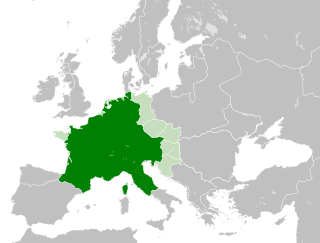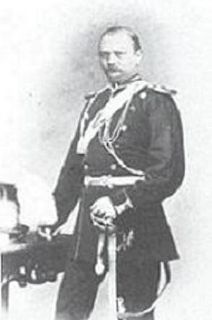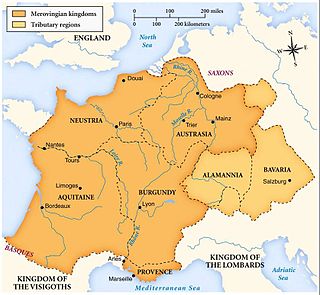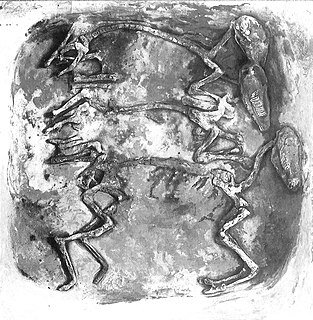 W
WThe concept of Germany as a distinct region in central Europe can be traced to Roman commander Julius Caesar, who referred to the unconquered area east of the Rhine as Germania, thus distinguishing it from Gaul (France), which he had conquered. The victory of the Germanic tribes in the Battle of the Teutoburg Forest prevented annexation by the Roman Empire, although the Roman provinces of Germania Superior and Germania Inferior were established along the Rhine. Following the Fall of the Western Roman Empire, the Franks conquered the other West Germanic tribes. When the Frankish Empire was divided among Charles the Great's heirs in 843, the eastern part became East Francia. In 962, Otto I became the first Holy Roman Emperor of the Holy Roman Empire, the medieval German state.
 W
WThe terms Kingdom of Germany or German Kingdom denote the mostly Germanic-speaking Eastern Frankish kingdom, which was formed by the Treaty of Verdun in 843, especially after the kingship passed from Frankish kings to the Saxon Ottonian dynasty in 919. The king was elected, initially by the rulers of the stem duchies, who generally chose one of their own. After 962, when Otto I was crowned emperor, East Francia formed the bulk of the Holy Roman Empire, which also included the Kingdom of Italy and, after 1032, the Kingdom of Burgundy.
 W
WThe Prince-Archbishopric of Bremen, also Archbishopric of Bremen, — not to be confused with the former Archdiocese of Bremen, and the modern Archdiocese of Hamburg, founded in 1994 — was an ecclesiastical principality (787–1566/1648) of the Holy Roman Empire, which after its definitive secularization in 1648, became the hereditary Duchy of Bremen. The prince-archbishopric, which was under the secular rule of the archbishop, consisted of about a third of the diocesan territory. The city of Bremen was de facto and de jure not part of the prince-archbishopric. Most of the prince-archbishopric lay rather in the area to the north of the city of Bremen, between the Weser and Elbe rivers. Even more confusingly, parts of the prince-archbishopric belonged in religious respect to the neighbouring diocese of Verden, making up 10% of its diocesan territory.
 W
WThe Carolingian Empire (800–888) was a large Frankish-dominated empire in western and central Europe during the early Middle Ages. It was ruled by the Carolingian dynasty, which had ruled as kings of the Franks since 751 and as kings of the Lombards in Italy from 774. In 800, the Frankish king Charlemagne was crowned emperor in Rome by Pope Leo III in an effort to transfer the Roman Empire from east to west. The Carolingian Empire is considered the first phase in the history of the Holy Roman Empire, which lasted until 1806.
 W
WThe County of Dassel emerged shortly after the turn of the 11th and 12th centuries when, after the extinction of the male line of the Billungs, its seat in Suilbergau, north of the Solling hills was divided into the domains of Einbeck and Dassel. Reinold of Dassel was able to secure rights similar to comital rights. The county lasted about 200 years, till it was abandoned in 1310 when there were no heirs. The most prominent member of the comital family was Rainald of Dassel, chancellor to Emperor Frederick Barbarossa and Archbishop of Cologne.
The County of Dannenberg was a fief in the Duchy of Saxony. Its heartland was largely identical with the present-day collective municipality of Elbtalaue in north Germany.
 W
WThe Duchy of Bavaria was a frontier region in the southeastern part of the Merovingian kingdom from the sixth through the eighth century. It was settled by Bavarian tribes and ruled by dukes (duces) under Frankish overlordship. A new duchy was created from this area during the decline of the Carolingian Empire in the late ninth century. It became one of the stem duchies of the East Frankish realm which evolved as the Kingdom of Germany and the Holy Roman Empire.
 W
WBerg was a state—originally a county, later a duchy—in the Rhineland of Germany. Its capital was Düsseldorf. It existed as a distinct political entity from the early 12th to the 19th centuries.
 W
WThe Duchy of Cleves was a State of the Holy Roman Empire which emerged from the medieval Hettergau. It was situated in the northern Rhineland on both sides of the Lower Rhine, around its capital Cleves and the towns of Wesel, Kalkar, Xanten, Emmerich, Rees and Duisburg bordering the lands of the Prince-Bishopric of Münster in the east and the Duchy of Brabant in the west. Its history is closely related to that of its southern neighbours: the Duchies of Jülich and Berg, as well as Guelders and the Westphalian county of Mark. The Duchy was archaically known as Cleveland in English.
 W
WThe Duchy of Westphalia was a historic territory in the Holy Roman Empire, which existed from 1180. It was located in the greater region of Westphalia, originally one of the three main regions in the German stem duchy of Saxony and today part of the state of North Rhine-Westphalia. The duchy was held by the Archbishops and Electors of Cologne until its secularization in 1803.
 W
WThe counts of Falkenstein were a medieval noble dynasty from Bavaria. The family flourished under the rule of the Hohenstaufen emperors.
 W
WThe village of Flemmingen is one of the eleven components of the cultural landscape Naumburg Cathedral and the High Medieval Cultural Landscape of the Rivers Saale and Unstrut that has been proposed by the Federal Republic of Germany for inscription in the List of World Heritage. The World Heritage nomination is representative for the processes that shaped the continent during the High Middle Ages between 1000 and 1300: Christianization, the so-called “Landesausbau” and the dynamics of cultural exchange and transfer characteristic for this very period.
 W
WGermania Slavica is a historiographic term used since the 1950s, that denotes the landscape of the medieval language border zone between Germans and Slavs in Central Europe on the one hand and a 20th-century scientific working group to research the conditions in this area during the High Middle Ages on the other.
 W
WGrand Burgher [male] or Grand Burgheress [female] is a specific conferred or inherited title of medieval German origin and legally defined preeminent status granting exclusive constitutional privileges and legal rights, who were magnates and subordinate only to the Emperor, independent of feudalism and territorial nobility or lords paramount. A member class within the patrician ruling elite, the Grand Burgher was a type of urban citizen and social order of highest rank, a formally defined upper social class of affluent individuals and elite burgher families in medieval German-speaking city-states and towns under the Holy Roman Empire, who usually were of a wealthy business or significant mercantile background and estate. This hereditary title and influential constitutional status, privy to very few individuals and families across Central Europe, formally existed well into the late 19th century and early part of the 20th century. In autonomous German-speaking cities and towns of Central Europe that held a municipal charter, town privileges or were a free imperial city such as Hamburg, Augsburg, Cologne and Bern that held imperial immediacy, where nobility had no power of authority or supremacy, the Grand Burghers (Großbürger) or patricians ("Patrizier") constituted the ruling class.
 W
WGuelders or Gueldres is a historical county, later duchy of the Holy Roman Empire, located in the Low Countries.
 W
WThe Hanseatic League was a commercial and defensive confederation of merchant guilds and market towns in Northwestern and Central Europe. Growing from a few North German towns in the late 1100s, the league came to dominate Baltic maritime trade for three centuries along the coasts of Northern Europe. Hansa territories stretched from the Baltic to the North Sea and inland during the Late Middle Ages, and diminished slowly after 1450.
 W
WIn the Middle Ages, Hellweg was the official and common name given to main travelling routes in Germany. Their breadth was decreed as an unimpeded passageway a lance's width, about three metres, which the landholders through which the Hellweg passed were required to maintain.
 W
WThe Landgraviate of Hesse was a principality of the Holy Roman Empire. It existed as a single entity from 1264 to 1567, when it was divided among the sons of Philip I, Landgrave of Hesse.
 W
WThe Counts of Hohenberg were an ancient Swabian dynasty in the southwest of the present-day Germany, in the state of Baden-Württemberg.
 W
WThe County of Katzenelnbogen was an immediate state of the Holy Roman Empire. Chatti Melibokus is a very old tribe who stayed on a high hill in the Bergstraße region of Hesse, in Germany. It existed between 1095 and 1479, when it was inherited by the Landgraves of Hesse.
 W
WThis is a list of monarchs who ruled over East Francia, and the Kingdom of Germany, from the division of the Frankish Empire in 843 until the collapse of the German Empire in 1918.
 W
WThe following is a list of German Gaue which existed during the Middle Ages.
 W
WThe Margraviate of the Nordgau or Bavarian Nordgau was a medieval administrative unit (Gau) on the frontier of the German Duchy of Bavaria. It comprised the region north of the Danube and Regensburg (Ratisbon), roughly covered by the modern Upper Palatinate stretching up to the river Main and, especially after 1061, into the Egerland on the border with Bohemia.
 W
WThe Maschen disc brooch is an Early Medieval fibula, which was found in 1958 during archaeological excavations of the late Saxon grave field near Maschen, in the Lower Saxony district of Harburg, Germany. On its face side, the fibula shows an unidentified saint with a halo. It was found in a woman's grave of the beginning of the Christianization of northern Germany, and is in the permanent exhibition of the Archaeological Museum Hamburg in Harburg, Hamburg.
 W
WA Meierhof or Meyerhof was a farm or building which was occupied or had been occupied by the administrator of a noble or ecclesiastical estate.
 W
WThe Margravate of Meissen was a medieval principality in the area of the modern German state of Saxony. It originally was a frontier march of the Holy Roman Empire, created out of the vast Marca Geronis in 965. Under the rule of the Wettin dynasty, the margravate finally merged with the former Duchy of Saxe-Wittenberg into the Saxon Electorate by 1423.
 W
WThe Merovingian dynasty was the ruling family of the Franks from the middle of the 5th century until 751. They first appear as "Kings of the Franks" in the Roman army of northern Gaul. By 509 they had united all the Franks and northern Gaulish Romans under their rule. They conquered most of Gaul, defeating the Visigoths (507) and the Burgundians (534), and also extended their rule into Raetia (537). In Germania, the Alemanni, Bavarii and Saxons accepted their lordship. The Merovingian realm was the largest and most powerful of the states of western Europe following the breaking up of the empire of Theoderic the Great.
 W
WThe Merovingian dynasty was the ruling family of the Franks from the middle of the 5th century until 751. They first appear as "Kings of the Franks" in the Roman army of northern Gaul. By 509 they had united all the Franks and northern Gaulish Romans under their rule. They conquered most of Gaul, defeating the Visigoths (507) and the Burgundians (534), and also extended their rule into Raetia (537). In Germania, the Alemanni, Bavarii and Saxons accepted their lordship. The Merovingian realm was the largest and most powerful of the states of western Europe following the breaking up of the empire of Theoderic the Great.
 W
WMining in the Upper Harz region of central Germany was a major industry for several centuries, especially for the production of silver, lead, copper, and, latterly, zinc as well. Great wealth was accumulated from the mining of silver from the 16th to the 19th centuries, as well as from important technical inventions. The centre of the mining industry was the group of seven Upper Harz mining towns of Clausthal, Zellerfeld, Sankt Andreasberg, Wildemann, Grund, Lautenthal und Altenau.
 W
WThe Oaths of Strasbourg were a military pact made on the 14th of February, A.D. 842 by Charles the Bald and Louis the German against their older brother Lothair I, the designated heir of Louis the Pious, the successor of Charlemagne. One year later the Treaty of Verdun would be signed, with major consequences for Western Europe's geopolitical landscape.
 W
WOstsiedlung is the term for the High Medieval migration period of ethnic Germans to and beyond the territories at the eastern periphery of the Holy Roman Empire and the consequences for settlement development and social structures in the immigration areas. Generally sparsely and only recently populated by Slavic and Baltic tribes, the area of colonization, also known as Germania Slavica encompassed the region east of the Saale and Elbe rivers, Lower Austria, Styria, the Baltics, the territories that conform to modern Poland, Bohemia, Slovakia, Slovenia, Hungary and Transylvania.
 W
WThe Principality of Göttingen was a subdivision of the Duchy of Brunswick-Lüneburg in the Holy Roman Empire, with Göttingen as its capital. It was split off from the Principality of Brunswick-Wolfenbüttel in 1286 in the course of an estate division among members of the ruling House of Welf. In 1495 the Göttingen lands were incorporated as integral part of the newly established Brunswick Principality of Calenberg, with which they stayed united until the territory was merged into the Electorate of Hanover.
 W
WRhenish Franconia or Western Franconia (Westfranken) denotes the western half of the central German stem duchy of Franconia in the 10th and 11th century, with its residence at the city of Worms. The territory located on the banks of Rhine river roughly corresponded with the present-day state of Hesse and the adjacent Palatinate region in the south.
 W
WDuke of Teck is a title which was created twice in Germanic lands. It was first borne from 1187 to 1439 by the head of a cadet line of the German ducal House of Zähringen, known as the "first House of Teck". The caput of his territory was Teck Castle in the Duchy of Swabia.
 W
WThe Viking raids in the Rhineland were part of a series of invasions of Francia by the Vikings that took place during the final decades of the 9th century. From the Rhineland, which can be regarded as the nucleus of Frankish culture, the Franks had previously conquered almost the whole of Central Europe and established a great empire.
 W
WThe County of Wölpe was the territorial lordship of a noble family in the Middle Ages in the Middle Weser Region near Nienburg/Weser which folded in 1302. The seat of the counts of Wölpe was the castle site at Erichshagen-Wölpe on the Wölpe stream in the borough of Nienburg in north Germany. The castle itself no longer exists.
 W
WThe Wulfsen horse burial is an early medieval horse burial, consisting of three horses, that was discovered in 1974 in a Saxon grave field in the village of Wulfsen, in the German district of Harburg. The find was rescued as a varnish profile, which is on display in the permanent exhibition of the Archaeological Museum Hamburg in Harburg, Hamburg.
 W
WThe County of Württemberg was a historical territory with origins in the realm of the House of Württemberg, the heart of the old Duchy of Swabia. Its capital was Stuttgart. From the 12th century until 1495, it was a county within the Holy Roman Empire. It later became a duchy and, after the breakup of the Holy Roman Empire, a kingdom.
 W
WThe House of Hohenzollern is a German former royal dynasty whose members were variously princes, electors, kings and emperors of Hohenzollern, Brandenburg, Prussia, the German Empire, and Romania. The family came from the area around the town of Hechingen in Swabia during the late 11th-century and took their name from Hohenzollern Castle. The first ancestors of the Hohenzollerns were mentioned in 1061.